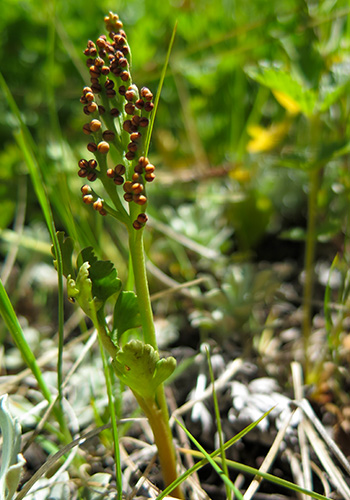
Moonworts and quillworts
Waterton Lakes National Park

Ferns and related spore-reproducing plants are found all over the world, from sea-level to high mountains. They are descended from some of the oldest plants of the earth's history, being found as fossils dating back nearly 400 million years.
For many centuries, the reproduction of ferns and related plants was a complete mystery because they do not have flowers. It was the belief in the time of the Druids that ferns produced very minute, invisible, short-lived flowers during midsummer's eve, a night with mystical powers.
Moonwort hot spot
Waterton is known for its plant diversity and unique species. This reputation is best exhibited by its amazing variety of small ferns called moonworts. While Waterton's eight different moonworts aren't the park's highest profile plants, they are another good indicator of its biodiversity. The Waterton moonwort (Botrychium x watertonense) is only found here and is considered the rarest plant in the park. Waterton's moonwort populations occur in fescue grassland meadows and in openings in lodgepole pine forests.
Moonwort bits and pieces
Moonworts were named for the lunar-crescent shape pinnae or leaves of various common Botrychium. However, not all moonworts have crescent-shaped leaves. Their shapes can be extremely variable which makes identification of species very difficult.
Each year the moonworts have the ability to produce a single leaf. The leaf has two sections, a reproductive spore-bearing part and a photosynthetic part. But moonworts can be fickle. They have the ability to skip a year and not emerge to produce a leaf. This disappearance in some years contributes to their reputation as rare.
One thing about finding moonworts is learning to look for them underneath the forest litter. Only a small portion of moonwort populations emerge above the forest floor's leaves and needles. Parting the litter and looking underneath could bring success.
Moonworts matter
While it appears that Botrychium species are adapted to moderate to low frequency disturbances, how they respond to disturbances such as fire, grazing and insect epidemics is not clear. Monitoring these populations and their habitats is important. At present, Waterton is hosting a moonwort inventory research project. The study is documenting population size and status, as well as looking at potential threats and management strategies to preserve the moonworts.
Quillwort craziness
While much is said about Waterton's geological history there is a group of plants that also link the park to prehistoric days.
Quillwort, the very word invokes ancient times when the earth was covered by foggy bogs and inhabited by strange and wonderful creatures. The Rev. Lachlan Shaw in his 'History of Moray', published in 1770 tells of mystic quillworts in Scotland.
Fossil remnants indicate that quillworts similar to those of today have existed for at least 22 million years, and that quillwort-like plants originated in the Upper Devonian Period, about 350 million years ago. Worldwide there are about 150 species.
Species at risk
To botanists, quillworts are the genus Isoetes. 'Isos' means 'equal' and 'etos' means 'year', referring to the evergreen habit of some species. Waterton is home to the Bolander's quillwort (Isoetes bolanderi). The park is the only place where this species is found in Canada. It is also found in higher elevation areas of the western US cordillera. COSEWIC currently lists it as 'threatened'.
Quillwort quirks
Quillworts are both aquatic and terrestrial. Bolander's quillwort is a "true" aquatic species and is found in lakes and ponds in the Alpine and Subalpine ecoregions where the climate is cool and relatively wet and the growing season is short.
Perennial plants, quillworts are typically 3 to 7 cm in height and consist mainly of a tuft of straight or curled quill-like leaves arranged in a spiral fashion on a swollen, modified stem called a corm. The narrowly spoon-shaped leaves have pointed tips and are layered one upon the other, the youngest leaves at the centre of the plant and the oldest leaves on the outside.
In the late summer or early autumn, mature quillworts produce clusters of spores in spore cases (sporangia) located at the flared base of each leaf. They produce two spore types, large female spores or megaspores and small male spores or microspores. Identification of different species of quillworts is usually based on the size and texture of the megaspores.
Helping out
The greatest threat to quillworts is habitat loss. Bolander's quillwort is very sensitive to water quality degradation and to disturbance (e.g. bank erosion by hikers). The park is planning to carry out monitoring and research to assess the current status of quillwort in the park, and any threats to the species.
Related links
- Date modified :